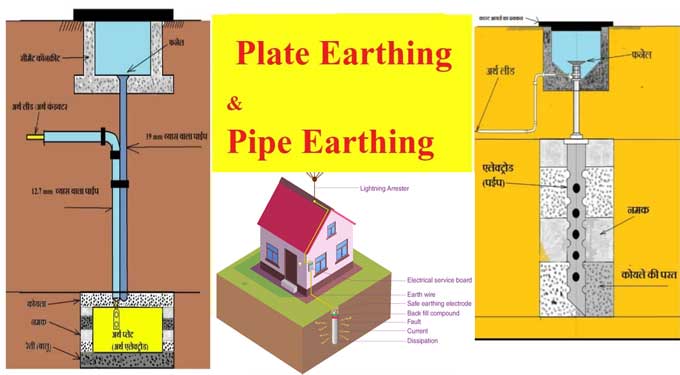
A Guide to Earthing: Types, Merits, and Procedures

By passing electrical charges directly to the earth using a low-resistance cable, earthing is the instantaneous discharge of electrical energy.
Electrical appliances and installations are linked to the earth with different types of the earth to prevent electrocution.
It is possible to earth wire in buildings, homes, machinery, and electrical equipment through plate earthing systems, strip earthing systems, rod earthing systems, or pipe earthing systems.
What is the process of Earthing?
In order to make sure the electrical appliance is safe, grounding/earthing or electrodes placed underground or near the soil are connected to the earthing/earthing system.
Earthing mats or electrodes with flat iron risers are installed beneath the ground's surface. A mat or electrode with a flat iron riser is installed beneath the ground's surface to conduct electricity.
If an overload current passes through the equipment or if the fault current causes a system fault, the fault current travels via the earthing system. A ground fault multiplies the earth mat's resistance by the earth mat's conductors, raising the voltage by the same amount. A fault current or overload can damage the equipment in this way.
Wires in a building are divided into three types: live, neutral, and earth. A buried metal plate connects the ground to the power plant and carries electric current from live and neutral conductors.
The ground wire is connected to all electrical equipment when it is in use, including TVs, iron boxes, heaters, coolers, stand fans, and refrigerators.
Varieties of Earthing
The grounding of electrical devices, housing, and wiring takes place in an earthed environment. Electric earthing systems can be classified into the following types:
1. Plate Earthing
Earthing is accomplished by placing a copper or galvanized iron plate vertically in a ground pit less than three meters underground. The moisture condition of the earth around the plate earthing system is essential to a more effective electrical grounding system.
To redirect the electrical charge within the earth, this plate is attached to electrical wires that are attached to the ground.
2. Pipe Earthing
An earthing pipe is a method by which a steel pipe is used to connect to the earth's electrical conductors for the purpose of connecting with electricity.
When pipe earthing is conducted, a vertically laid 38 mm diameter galvanized steel pipe with a 2-meter length is used as an earth electrode. Iron pipe size is determined by soil moisture and current strength. Depending on the amount of moisture in the soil, it will be possible to install the steel pipe up to a certain depth.
A pipe earthing system is one of the best and most effective methods for earthing, and it is also one of the most economical methods.
3. Rod Earthing
This method of earthing is carried out by inserting a copper rod together with a galvanized steel pipe vertically into the ground, to the desired value, using a hammer or manually pounding the rod into the ground; the lengths of the electrodes implanted reduce the resistance of the earth.
By burying the short-circuit rod at a certain depth, the electricity is securely redirected to the ground.
Earthing techniques such as this one are suitable for sandy soils, and they are also very affordable.
4. Wire and Strip Earthing
The earthing method uses strip electrodes buried in horizontal trenches with a minimum cross-sectional area of 6.0 mm2 and a minimum depth of 0.5 m. These electrodes must have a minimum cross-sectional area of 25 mm x 1.6 mm if they are made of steel or galvanized iron.
In order to provide sufficient earth resistance, a conductor should be buried in the ground for a minimum of 15 meters.
5. Earthing across the Waterman
Earthing is performed using waterman (Galvanized GI) pipes. GI pipes should be checked for resistance and earthing clamps should be used to minimize it for proper earthing.
If a stranded conductor is used as the earth wire, make sure the end of each strand is clean and straight, and parallel so that it may be snugly connected to the waterman pipe.
What are some of the merits of Earthing?
Earthing is very important as it has many advantages, some of these advantages are as follows:
To learn more, watch the following video tutorial.
Video Source: Life is Awesome Civil Engineering Plans
1. Neutrality is considered to exist on the earth since it has no potential. By connecting low equipment to the ground via low resistance cable, balancing is achieved.
2. Rapid voltage increases and overloads require adequate earthing precautions so that neither the object nor the person is negatively affected.
3. Through earthing, a building can be protected from electrocution in the safest and most effective way.
4. Fire hazards that would otherwise arise from the current leak are reduced by the earthing method.
5. Electrical systems can use metal without considering its conductivity since properly earthed metal won't transmit current.


